The fancy guppy is a very popular option for new aquarists and fish breeders, but did you know that they’re also one of the most diverse species in the aquarium trade? There’s a dizzying array of tail lengths, shapes and colors to choose from among the guppy breeds. Let’s take a look at 55 common and rare types of guppies!
How Many Different Types of Guppies Are There?
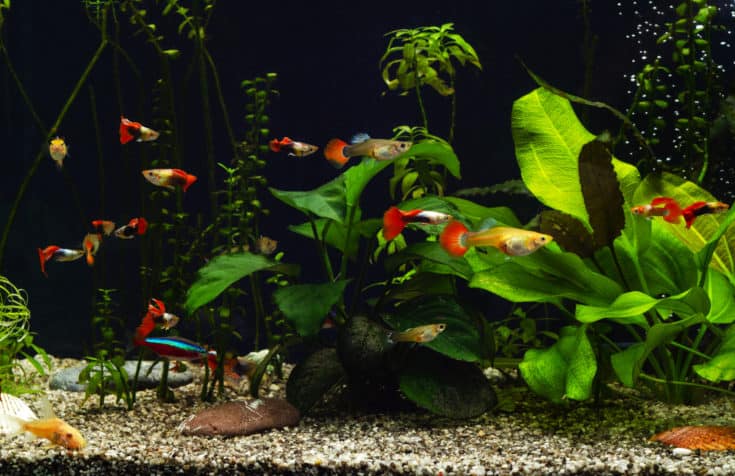
There’s actually no accepted answer to the above question since it just depends on how you categorize guppies with different traits. People who breed show guppies often use different criteria than scientists, researchers or conservationists. There’s no hard and fast rules for dividing guppies into groups based on their physical traits.
So a fancy guppy could legitimately end up in different categories depending on who’s making the list and the traits they’re interested in. Still, there are a few things that hold true for all guppy varieties:
- They are a sexually dimorphic species, so male and female guppies appear distinctly different as adults and can be divided into gender groups prior to reaching sexual maturity.
- Male guppies are generally considered to be the most desirable, especially for folks interested in showing fish.
- They come in a huge variety of rainbow and metallic colors and patterns, but their signature feature is usually their fancy tails.
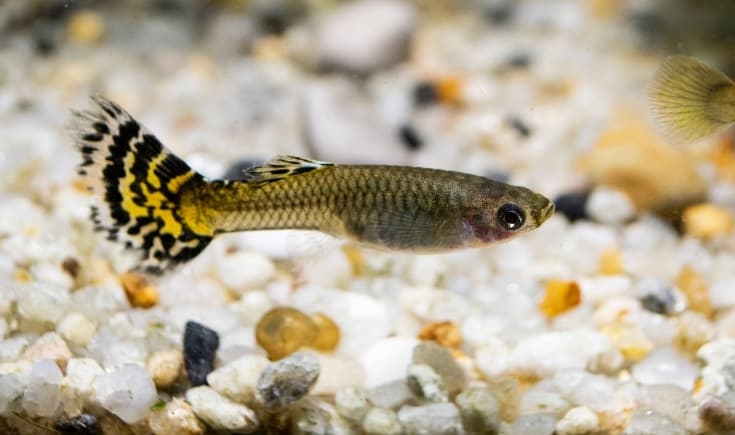
- Female guppies are larger and lack the fancy tail shapes. Similar to the plain female Betta fish, they are a drab brownish/grey color (although some varieties also show a hint of color or pattern on their tail)
To keep things simple, I’m going to break the guppy fish types into 55 groups based on their species, tail shape, body and eye colors and a few other unique traits. Just remember, these are loose categories and some fish may fall under multiple types.
Species of Guppy
There’re over 300 recognized species of guppy in the Poeciliidae family, but only a few are commonly seen in the aquarium trade. I’ll cover this in another post, but the natural history of guppies is complicated and convoluted. Without DNA testing, it’s often impossible to identify a guppy’s species-mix definitively.
Domesticated guppies, no matter what their species listing says, are nearly all hybrids and can (and will) freely interbreed with each other if given the opportunity. Unless you’re buying wild stock straight from South America, any fish you see in the trade likely bears traces of at least 3 different species of guppy.
1. Fancy Guppy
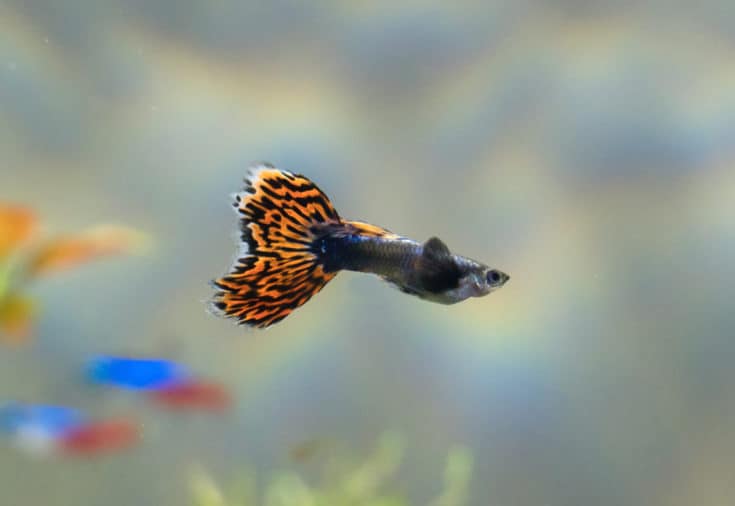
The Common or Fancy Tail Guppies (Poecilia reticulata) are one of the oldest types and have been popular with hobbyists for over 100 years. They’re usually the largest species available in shops and are hardy community fish. They’re especially noted for their extensive-tail shapes and distinct, highly bred color morphs.
2. Endler’s Guppy

Endler’s guppies are closer in appearance to wild-type fish, but still show more variety in their colors and tail shapes than true wild types. They descend from populations collected in the 1960’s by the renowned scientist, John Endler. There’s currently a lot of debate about how this species should be identified.
Wild populations in Trinidad may be termed Poecilia wingei by conservationists, but scientifically these guppies are still considered Poecilia reticulata. Fish sold as P.wingei may be true Endler’s, but they may also be from unrelated, more recent wild-type lines.
3. Swamp Guppy
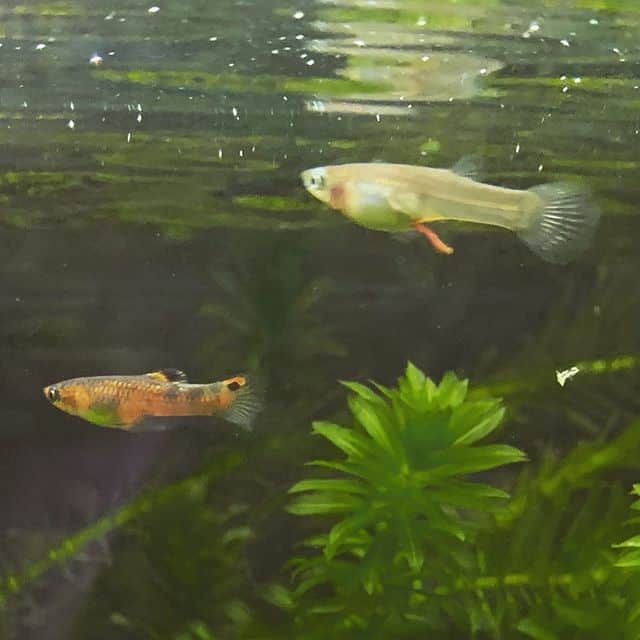
The Swamp Guppy (Poecilia picta or Micropoecilia picta) is a rare guppy fish that’s only been available in the trade for about a decade. Wild populations are often found in coastal streams and estuaries of Trinidad, and they can tolerate brackish aquariums. The Scarlet Swamp morph is one of the most desirable and impressive varieties.
Guppy Types by Tail Shape
A popular way to categorize male guppies is by the shape of their caudal fins (tails), since even wild males have longer, fancier tails than female guppies.
4. Fantail
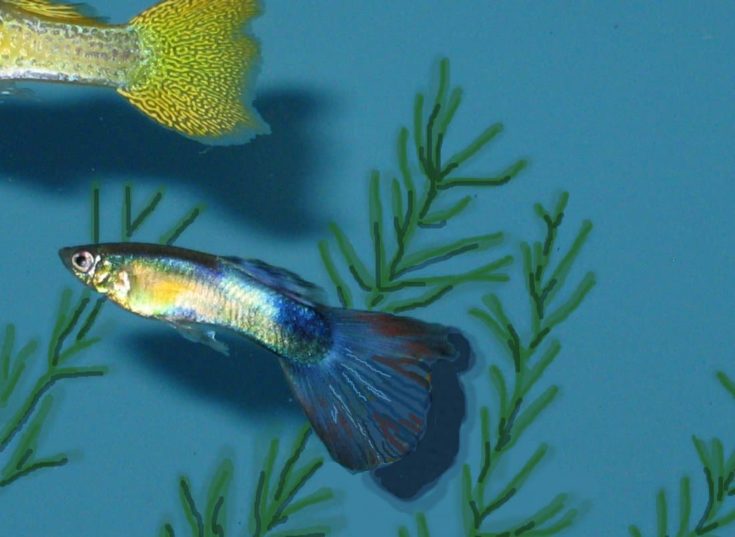
The Fantail guppy has a curved tail that’s almost as long as it is wide and spreads out like a fan behind the male as he swims. Fantails are commonly seen for sale in pet stores but are not highly regarded by show breeders.
5. Veiltail
Veiltail guppies have an extra long tail shaped like an isosceles triangle, with straight edges that emerge from the caudal peduncle (base of tail) at a 45° angle. The tail should be the same length as their body.
6. Triangle Tail
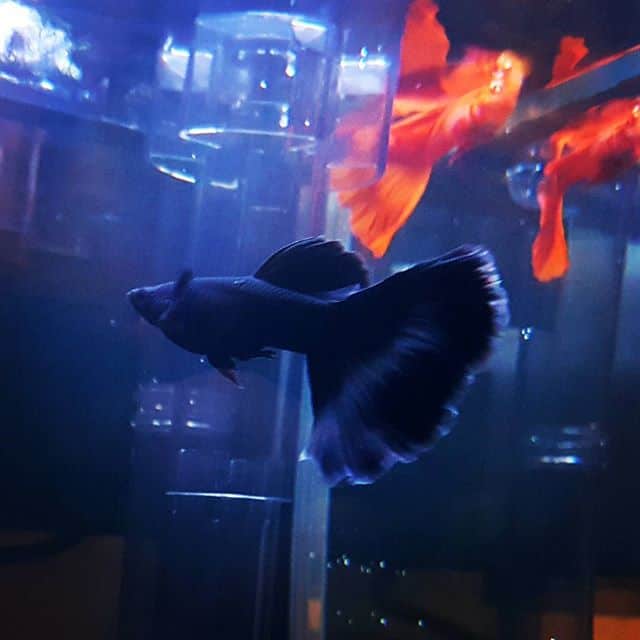
Triangle or Delta Tail guppies have triangular-shaped tails that spread in straight lines at a 70° angle from the caudal peduncle. Their tails should be about ⅘ the length of their bodies, so they’re wider and shorter than the veiltails.
7. Lyretail
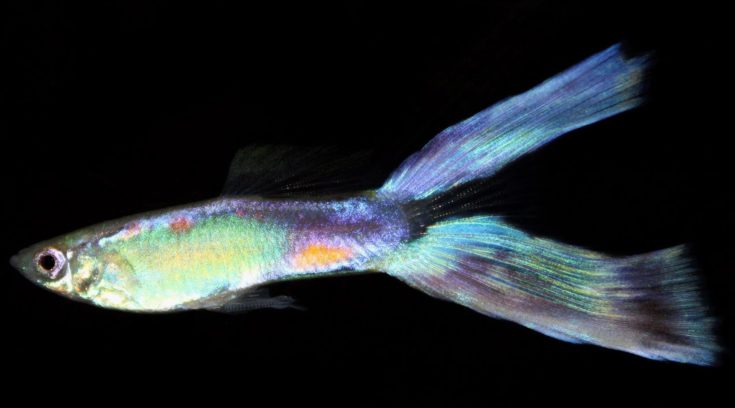
The Lyretail is a beautiful guppy morph with a tail shaped like a lyre, and closely resembles the Double Swordtail. The central part of the tail is short, about ⅖ the length of the body, but the curved upper and lower rays extend further to about ⅘ of the body’s length.
8. Roundtail
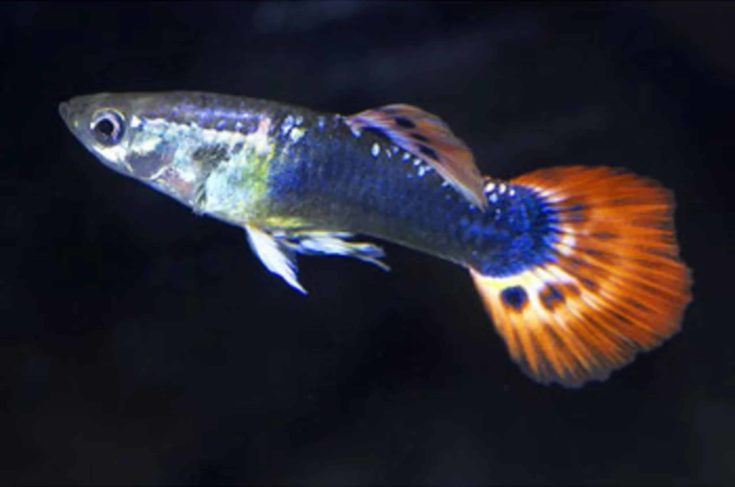
Roundtail guppies have a short tail with curved, rounded edges that extend to about half the length of their body. The shape is similar to tails seen in wild stock, but recent interest from European breeders have increased the popularity of this morph.
9. Scarf Tail
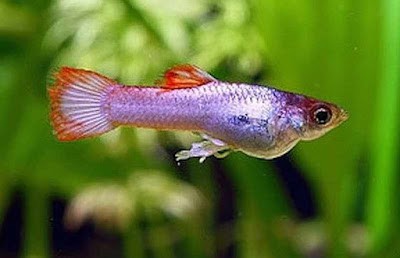
The Scarf or Flag Tailed guppy is a very rare morph that has a long, rectangular-shaped tail that extends to nearly the length of their body. Thought to be a mutation of the Delta Tail, there are only a few breeders in the world that work with this trait.
10. Bottom Swordtail
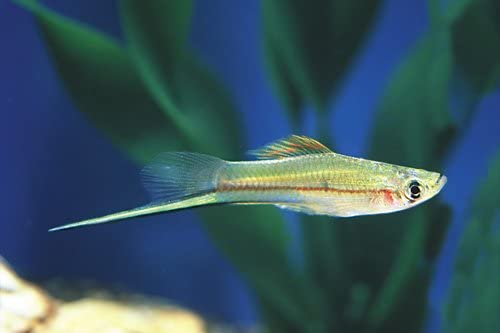
Bottom Swordtail guppies have short, oval-shaped tails with a sword-like lower ray that extends from the body axis at a 15° angle. The oval part of the tail usually only extends to about ⅖ of the body length. This older morph is not available in many colors.
11. Double Swordtail
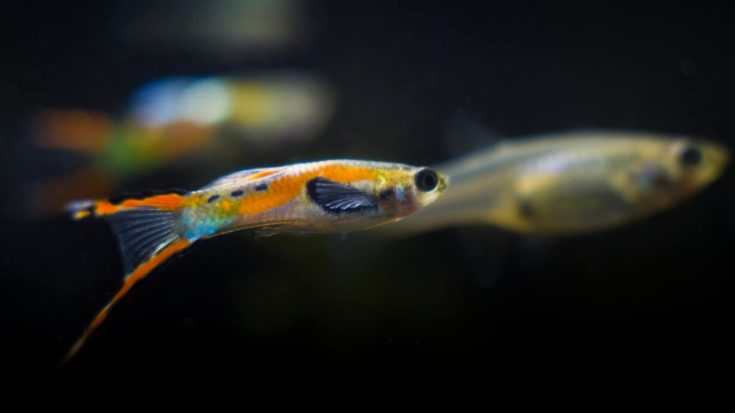
Similar to the Lyretail, the Double Swordtail guppy has a short tail with long sword-like rays extending from the upper and lower part of the caudal peduncle. The rays are the same length as the body, and their outer edges form an angle of 30° or more.
12. Top Swordtail
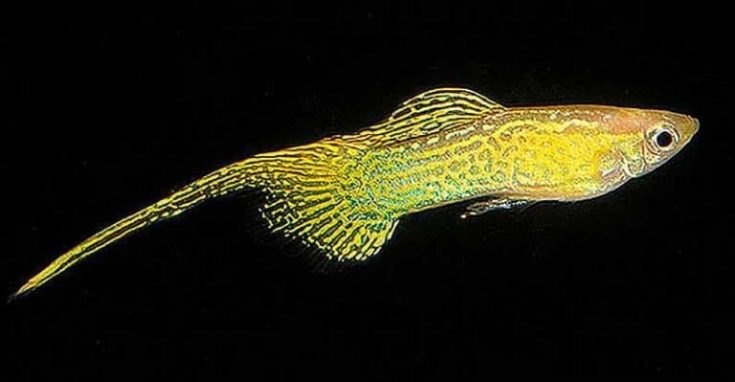
Top Swordtail guppies look just like the Bottom Swordtails, but with their tail morphology reversed. They have a longer upper ray that’s either parallel to their bodies or angled at 15°. It’s common to see upper and lower swordtail traits in wild males.
13. Cofer Tail
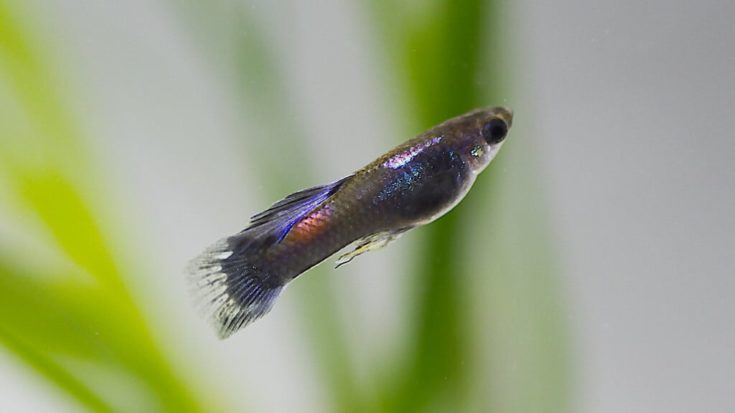
The Cofer or Spade Tail guppy has a tail shaped like a mining spade that only extends to half the length of their bodies. Their tails are almost as wide as they are long, and have a distinct point at the tip. This morph is probably closely related to the Roundtail trait.
14. Half-Moon Tail
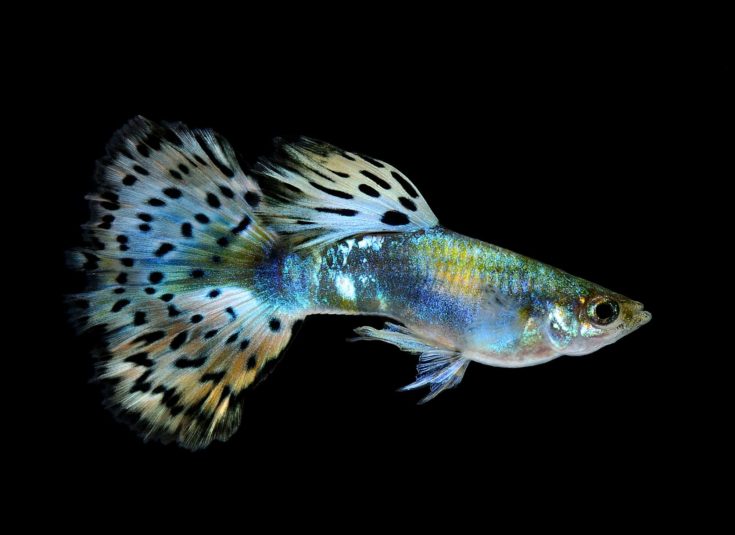
Half-Moon Tail guppies have long tails that emerge at a 180° angle from the caudal peduncle. When the tail is fully spread it forms a half-circle shape. This is a newer morph and is not yet accepted in the show circuit.
15. Spear Tail
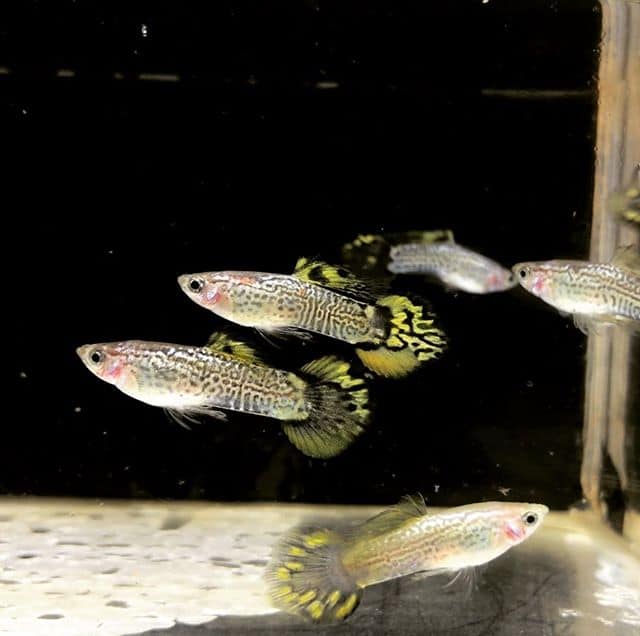
The unique Spear Tail guppy is probably a mutation of the Round or Cofer Tail trait and is rarely seen in the trade. Their tails are shaped like a spear tip and come to a point at the end, and are as long as they are wide.
16. Pintail
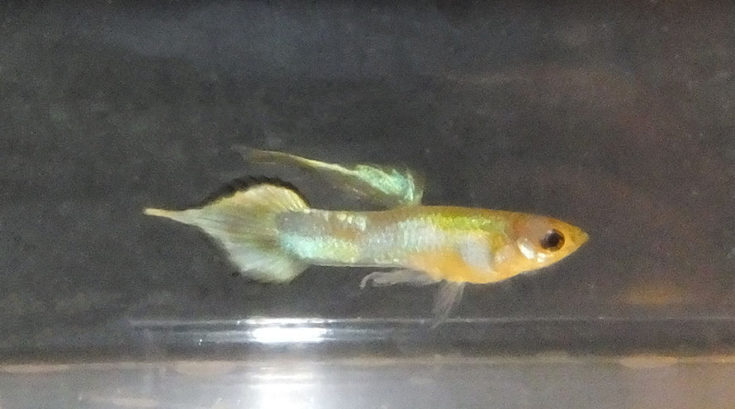
The Pin or Needle Tail guppy has a short, round tail with a central ray that extends to the length of their body. The round portion is usually about ⅖ the length of their bodies and as wide as it is long.
Guppy Types by Body and Tail Patterns
Depending on your guppy’s genetics, they may display a variety of different patterns of color on their bodies or tails. These “cover colors” overlay the base color of the guppy and are usually darker or metallic in color. Some markings are limited to either body or tail, but many may appear on both.
17. Tuxedo Guppies
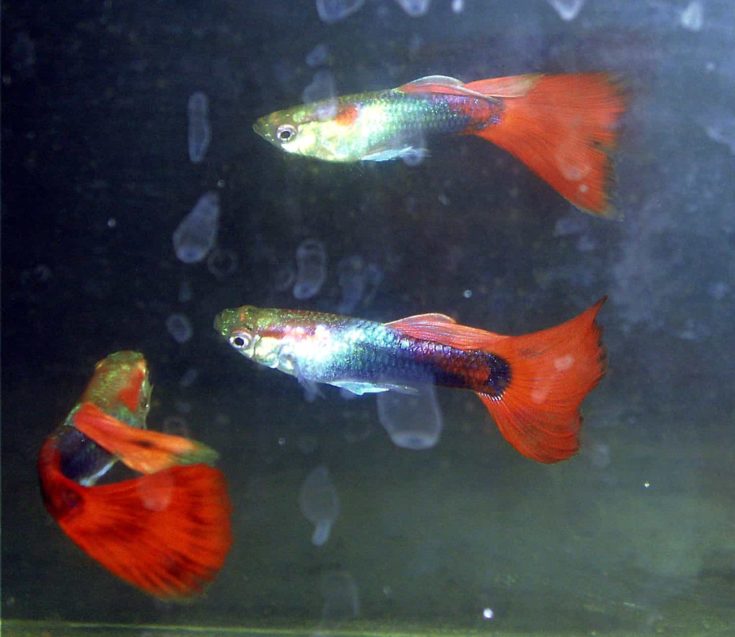
Tuxedo pattern guppies have a lighter color on the front half of their bodies, and a darker blue, black or other solid color on the back part of their bodies. Their dorsal fins and tails may be the same dark color, as is seen in the many Half-Black color morphs.
18. Cobra Guppies
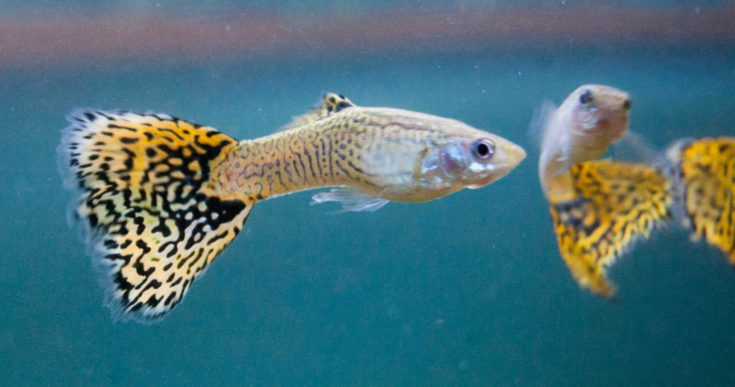
Cobra patterned guppies look similar to the Snakeskin morph but have rosette shaped markings mixed with vertical bars on their bodies and sometimes their tails. Females with the trait will often show hints of this pattern on their bodies, too.
19. Snakeskin Guppies
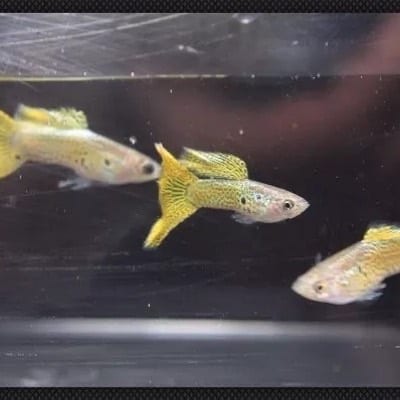
Snakeskin patterned guppies have a meandering pattern of light or dark colors that wind around their bodies, like a snake slithering through the grass. In the show world, Snakeskin and the Lace guppies (below) are considered in the same category for judging, since they are genetically related.
20. Lace Guppies
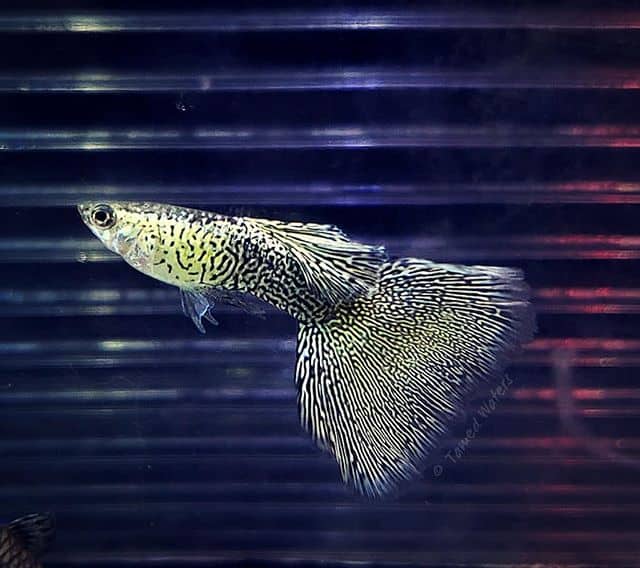
Fish that exhibit a pattern similar to the Snakeskin, but with a fine net-like mix of light and dark tones, are called Lace patterned guppies. This morph is genetically related to the Snakeskin pattern and is judged in the same category.
21. Leopard Guppies
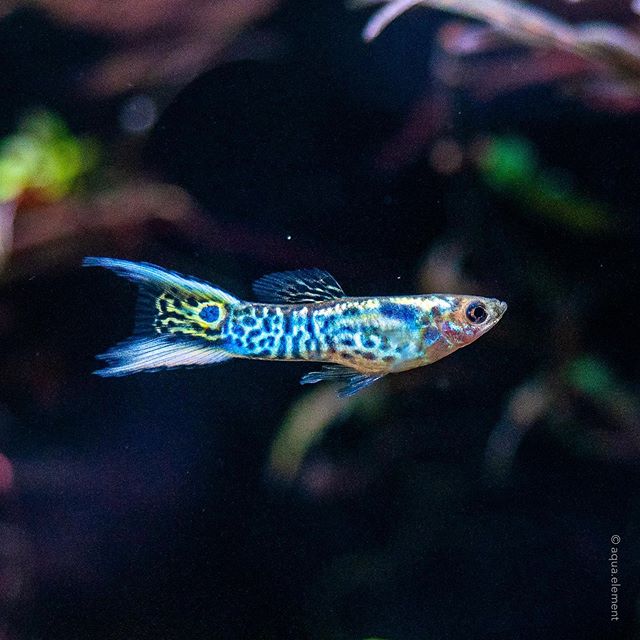
Leopard patterned guppies exhibit impressive dark leopard-like spots or blotches of color on their dorsal fins and tails, and sometimes on their caudal peduncle and body as well. The contrasting darker pattern really stands out against their brighter base colors!
22. Mosaic Guppies
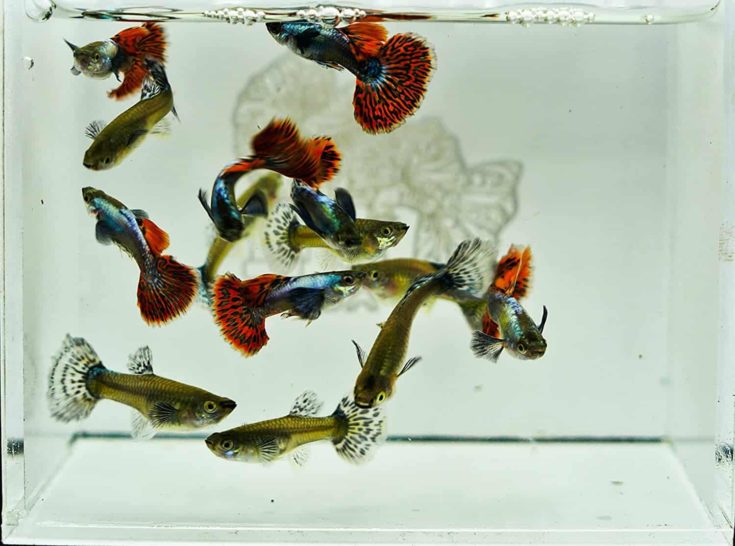
Mosaic patterned guppies have irregular dark markings and patches on their dorsal fins and tails. This morph is related to (and often closely resembles) Leopard guppies. Mosaic’s may show a mix of base colors under their tail patterns.
23. Glass Guppies
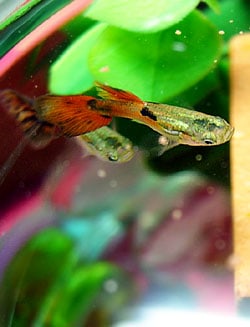
Glass or Glassbelly guppies have a genetic mutation that prevents them from producing guanine. This mutation means their scales don’t shimmer under light, and are more opaque than normal fish. Glass guppies are often albino, or have a red or blond base color.
Guppy Types by Coloration
Next to their tail shape, the definitive way to describe or categorize guppies is by their base and cover color(s). In the show world, there are 10 accepted base colors, but other colors overlaid on top of the base create new, unique morphs like the Half-Blacks and Bronze guppies.
24. Albino Guppy
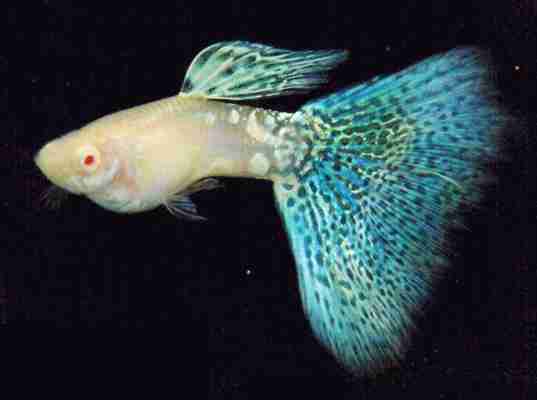
Albino guppies lack melanin, and so they don’t exhibit any black or darker markings. Albinos always have red or pink-colored eyes, but their body color can vary depending on their genetic mix. White albinos usually appear slightly pinkish, but a Half-Black albino may appear pastel-colored.
25. White Guppy
White guppies are distinguishable from albino fish by their black eyes, and they have a milky white base color that doesn’t have a pink or reddish tinge. The goal is to produce a line that shows no other secondary colors or patterns.
26. Black Guppy
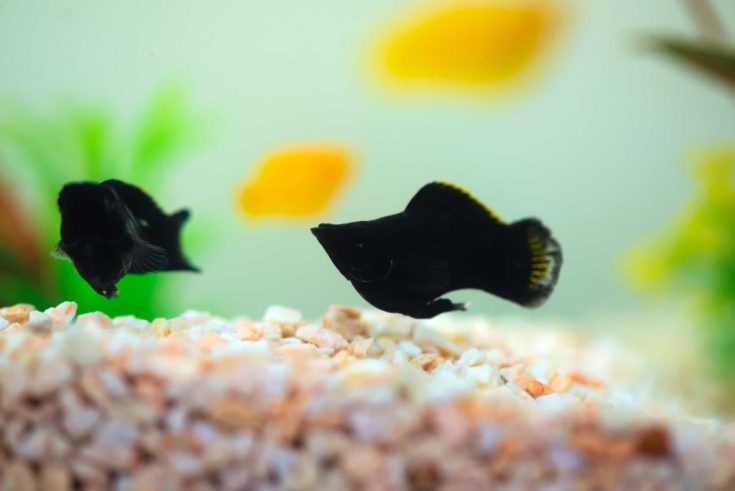
Black guppies should have a deep, rich color similar to charcoal and ideally should not show any other colors or patterns on top of the black base. Smaller fish usually show better, as larger ones start to appear dark grey or mottled as they grow.
27. Blue Guppy
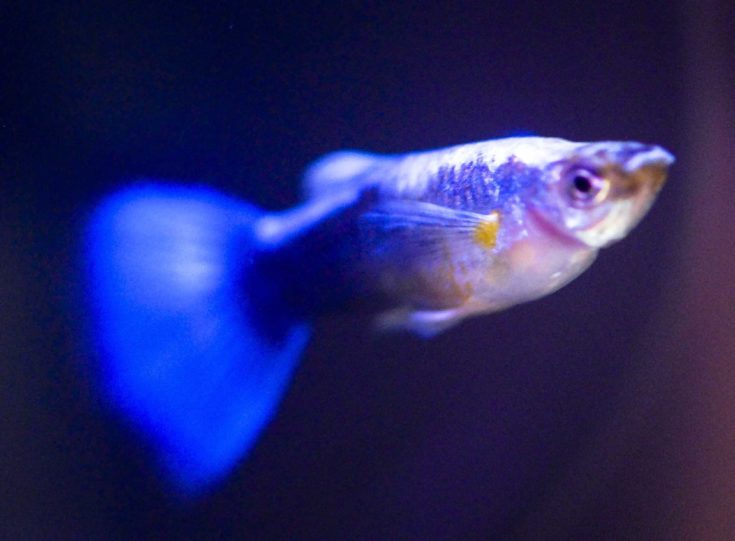
Blue guppies exhibit a rich blue color that can range from a pale sky blue to a deep midnight shade. Blue is an iridescent cover color in guppies, so blue fish may appear in different shades depending on their lighting conditions.
28. Neon Blue Guppy
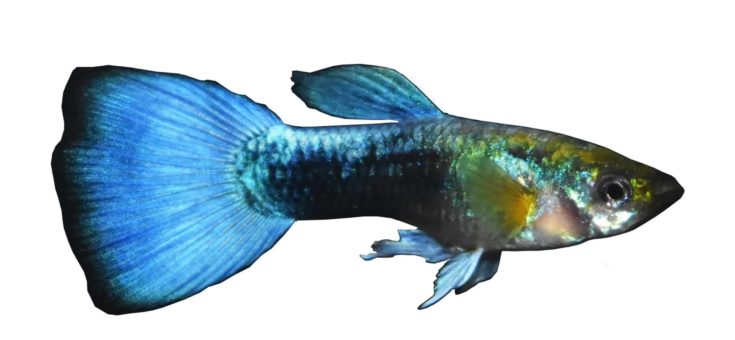
Neon Blue guppies usually have a color that’s a brighter shade, but they also come in a red color morph. In guppy shows, Neon Blue fish are usually in the same group as the Blue unless their cover color or pattern places them in another category.
29. Japanese Blue Guppy
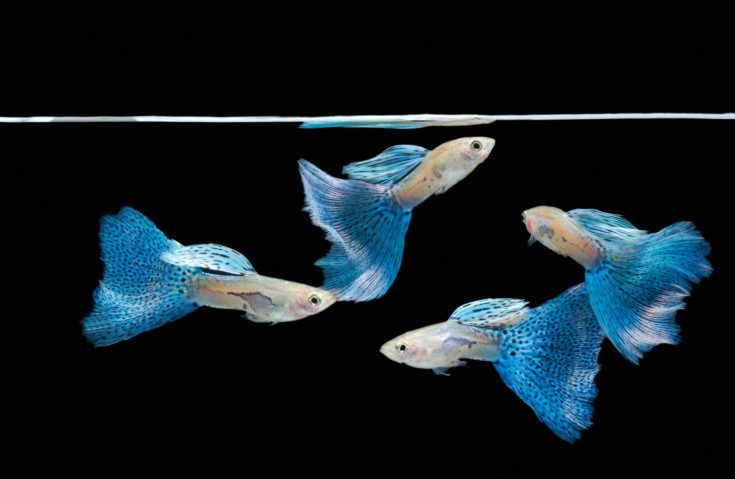
Bred from the Endler’s line, these guppies exhibit an intense bright blue color very similar to the blues seen in wild fish. These fish are often Bi or Multi-Colored, with the blue showing on the rear parts of their bodies or tail. This is a very popular color morph and is often seen on guppies with swordtails.
30. Purple Guppy
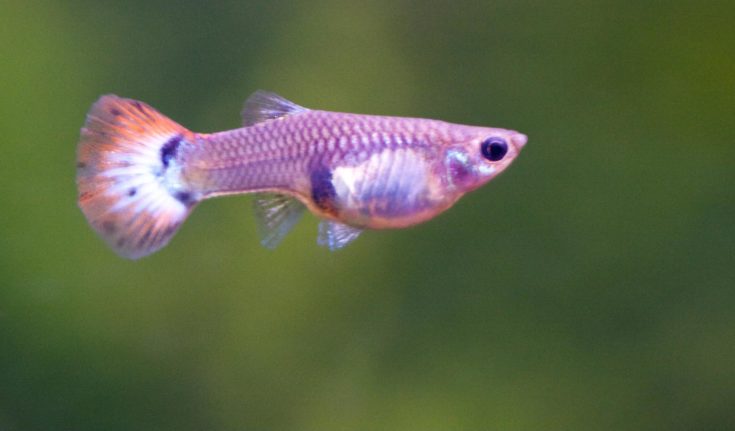
Purple guppies are genetically similar to the Blues but show a deep, rich purple on their dorsal fins and tails. Purple is a newer color group for showing fish, but this morph is uncommon and can command a high price from breeders.
31. Bronze Guppy
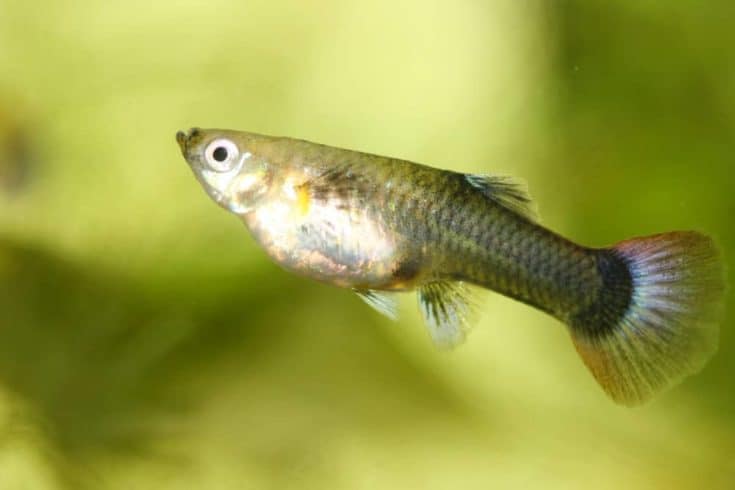
Bronze guppies are similar to Goldens and are judged in the same category. These guppies must show at least 25% golden-colored body scales outlined in black to qualify. Most Bronze guppies in the show circuits either have Red or Green Bi-colored tails.
32. Green Guppy
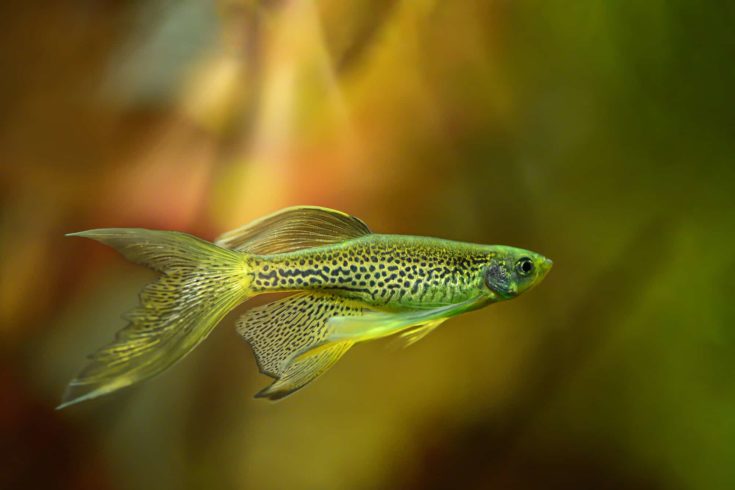
The rarest color morph is the elusive Green guppy. It’s extremely hard to breed true Green guppies, as most fish are actually Bi-colored Blue/Greens or show purple colors under different lighting conditions.
33. Red Guppy
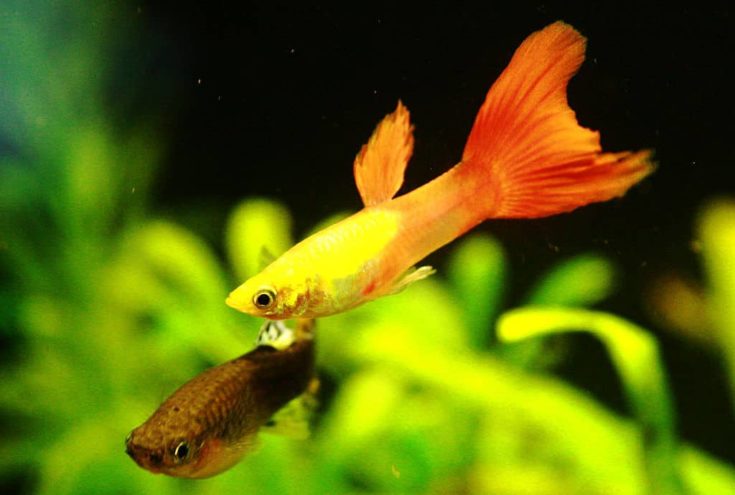
Red guppies can be a bit confusing to explain, since they can show up in grey, gold and albino lines. The gold and albino types are the most popular morphs. Depending on their underlying purple, blue and black colors, these fish range from maroon to orange in color.
34. Yellow Guppy
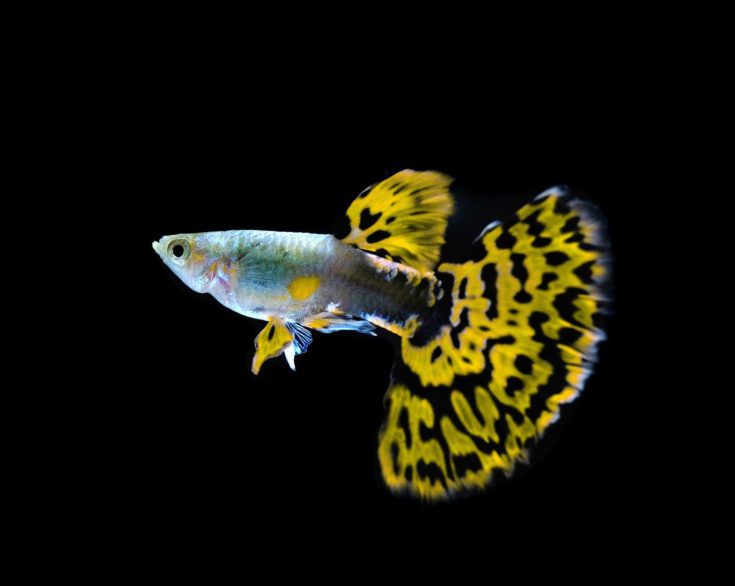
Similar to Bronze and Goldens, Yellow guppies usually carry the blonde gene to minimize the effects of the darker colors on their bodies and fins. Yellows should be a bright shade but many also have metallic cover colors that give them a golden appearance.
35. Golden Guppy
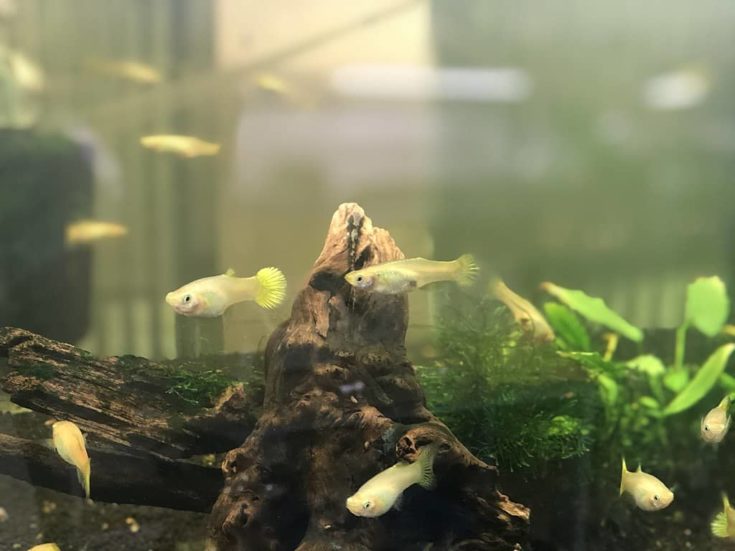
Golden guppies are similar to Bronze fish, and have at least 25% yellow scales on their bodies, but lack the black markings of a true bronze. This trait is often mixed with the metallic cover colors to enhance the golden appearance.
36. Half-Black Green Guppy
Half-Blacks (or HBs) are fish with the Tuxedo trait, and are categorized by their secondary color. Half-Black Green guppies are a rare morph with a half to ¾ black body and green dorsal and caudal fins.
37. Half-Black Blue Guppy
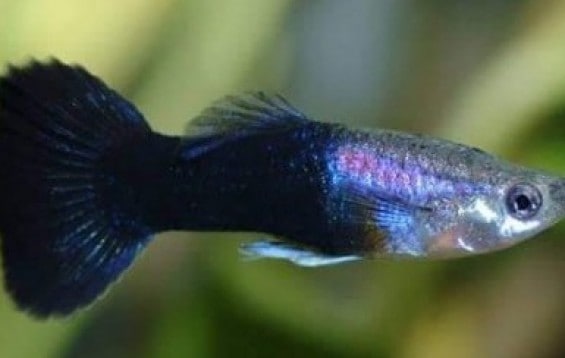
Like the Greens above, the Half-Black Blue guppy shows half to ¾ black on their bodies and have blue dorsal and caudal fins. Guppies must be a true blue to be judged in this category, and fish with greenish shades would be disqualified.
38. Half-Black Yellow Guppy
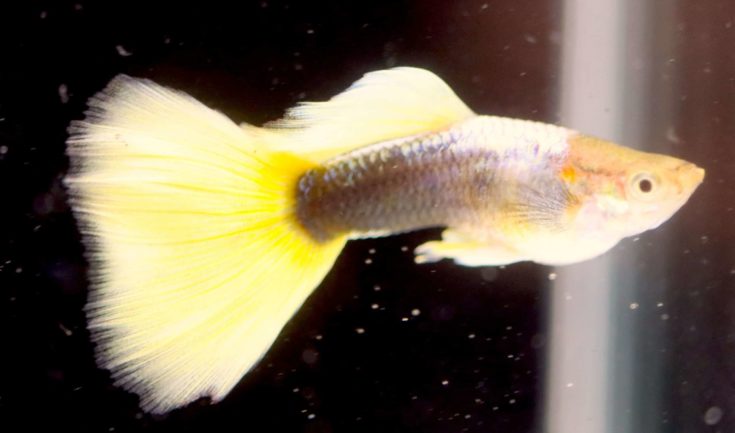
Half-Black Yellow guppies are a beautiful line of fish that’s hard to maintain, as the colors often fade after a few generations. Their pale to golden yellow colored fins really stand out against their dark black bodies.
39. Half-Black Red Guppy
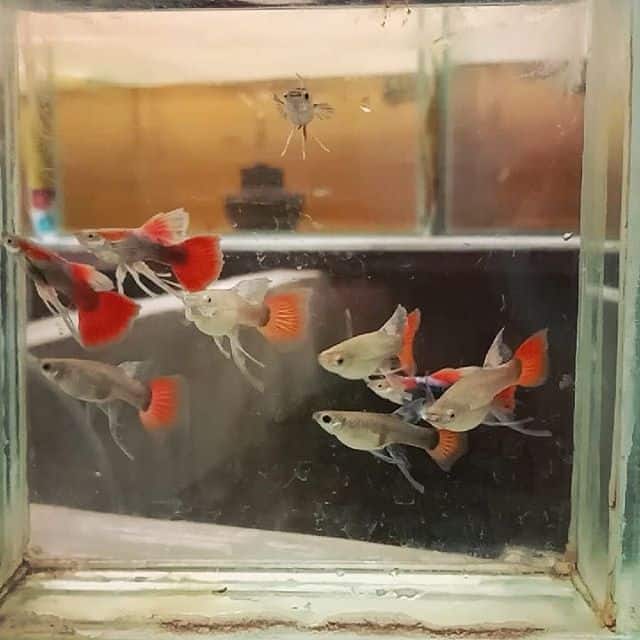
Half-Black Red guppies ideally should have the HB body type with vivid red dorsal and caudal fins. But this strain can be hard to develop. Red guppies with blonde or albino traits show a more intense and pure red, but obviously this would reduce the black body color.
40. Half-Black Purple Guppy
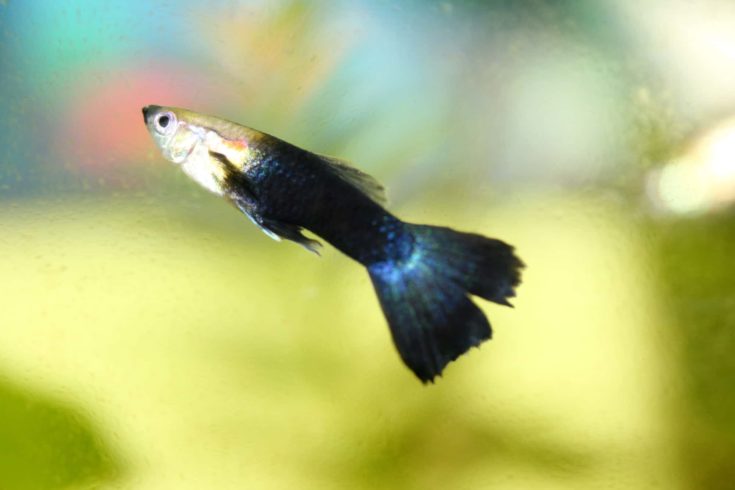
Like the HB Blue, the Half Black Purple guppy has a half to ¾ black body with a vibrant purple dorsal and caudal fins. Like all the HBs, the fish must be Bi-colored and not show any other patterns on their body or tail.
41. Half-Black Pastel Guppy
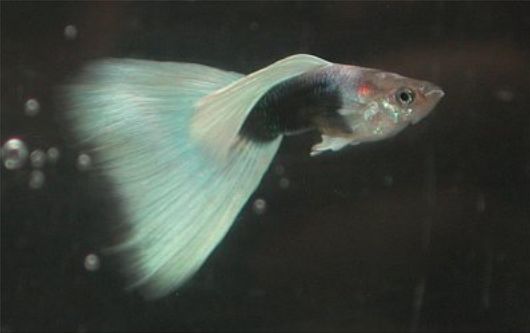
The Half-Black Pastel guppies are any HB fish with solid-colored pastel tails except for yellows (which would be judged as HB Yellows). The most common morph in the show world is the White Pastel color.
42. Solid Colored Guppies
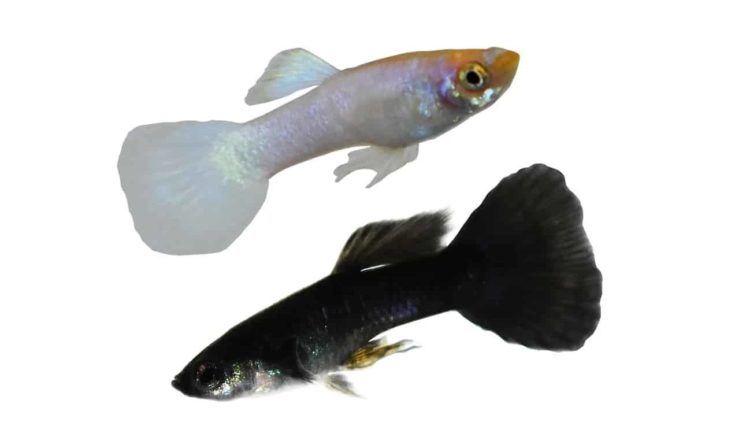
Solid colored guppies are those that only exhibit one primary color on their bodies and fins, usually in the red, blue, purple, yellow or green shades. Solid guppies often have paler heads and show various shades of colors on their bodies and fins.
43. Koi Guppies
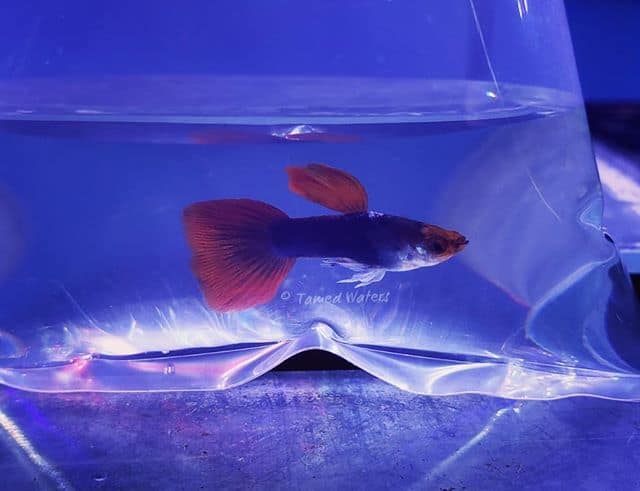
Koi-colored guppies have color patterns that resemble goldfish or koi. The most common morph are guppies with red tails and heads with white bodies, and the trait is often apparent even in the female lines.
Interested in other freshwater fishes with common names that start with the letter K? Check our list here.
44. Bi-Colored Guppies
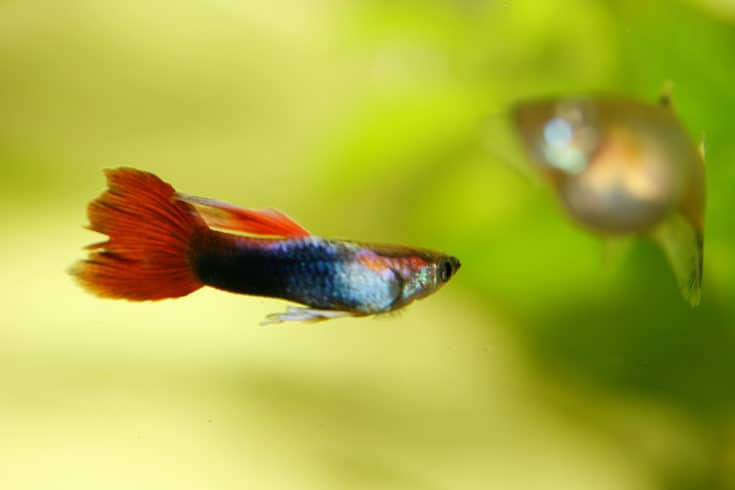
Bi-Colored guppies are fish with two colors, but they may also have body or tail patterns as well. They must have a dominant base color and show at least 25% of their secondary color in their tail to officially be considered Bi-Colored. At shows, Bi-Colors are grouped as Blue/Greens, Reds or AOC (Any Other Color).
45. Metal Guppies
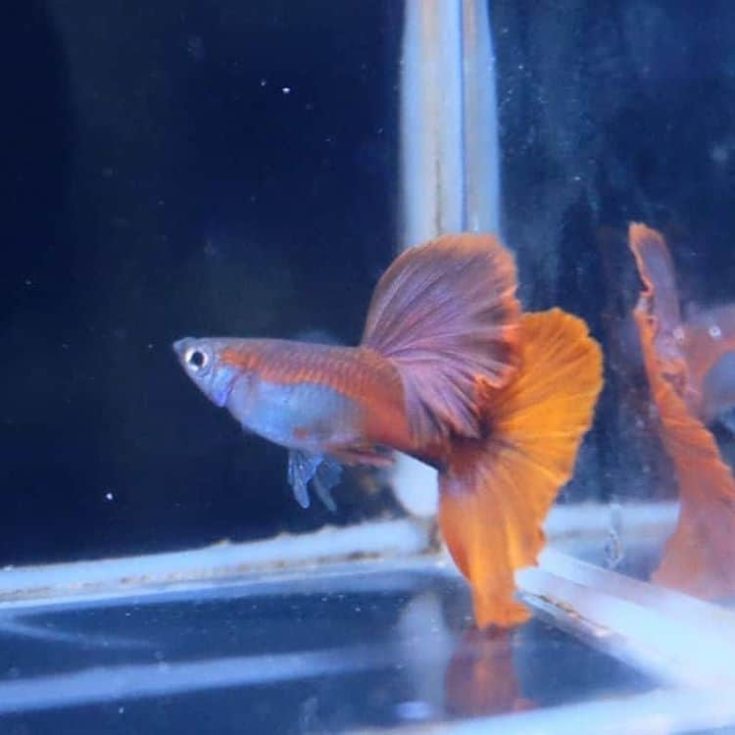
Metallic guppies aren’t judged in a separate category in the show world because this trait is common in both fancy and wild-type guppies. These fish have unique pigments in their scales (known as iridophores) that make the light shimmer like it’s reflecting off a metal surface and can make other colors really stand out.
46. Multi-Colored Guppies
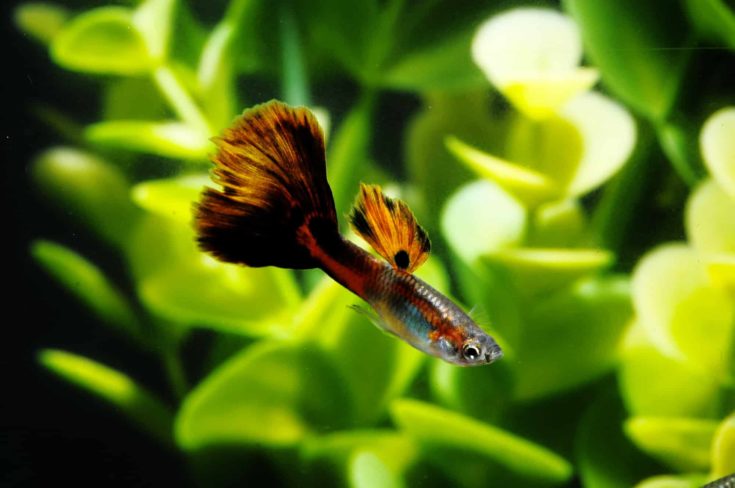
Multi or Party Colored guppies have at least 3 or more distinct colors in their tails, and are often combined with body or scale patterns. Each color must cover at least 15% of the tail, and their dorsal fins should match their tails in both colors and patterns.
47. Panda Guppies
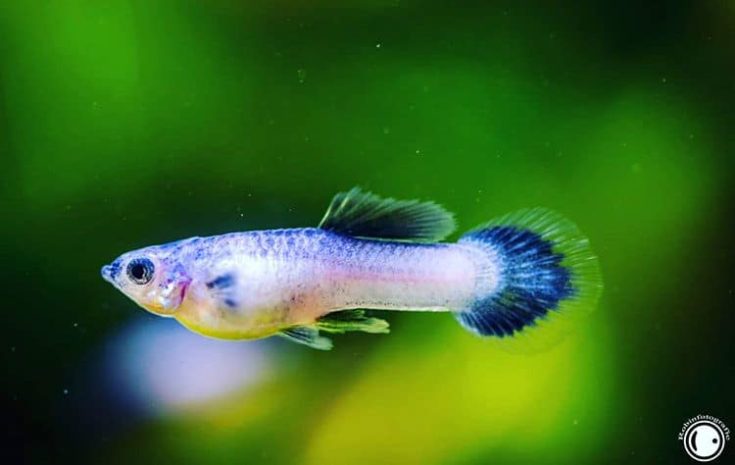
Panda guppies are a newer color morph, and have a partially black to dark blue body with a darker tail and silver or lighter blue markings on the head. These fish are difficult to find but are becoming more common.
48. Jarawee Lazuli Guppy
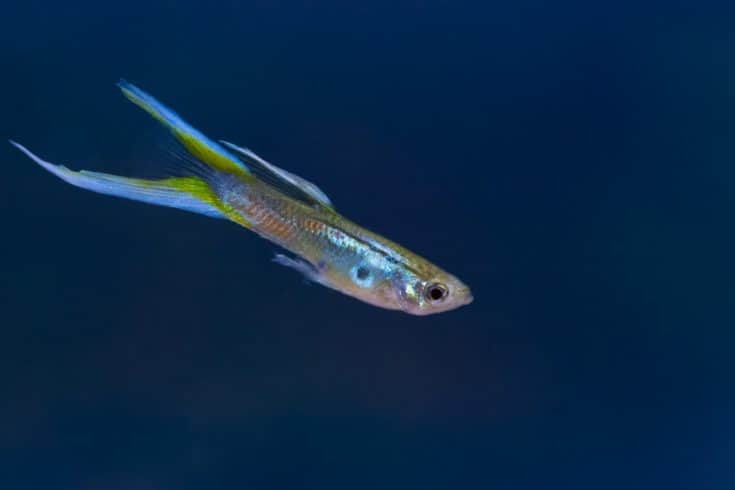
This unique morph from Jarawee Farms in Thailand looks similar to the wild-type guppies but has a mix of neon colors on the body and fins along with a large dorsal fin and fancy scissortail. They’re uncommon in the US but are becoming more available.
49. Moscow Guppy
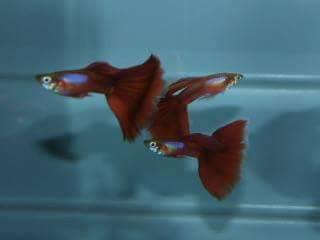
Moscow guppies are a unique line bred in Russia in the 1960’s that were smuggled into the US sometime in the 80s. They are rare and expensive morphs, and can’t be crossed with other strains unless you don’t mind diluting your line. They are bigger than other guppies and have longer dorsal and caudal fins, and are usually solid colored.
50. Platinum Guppy
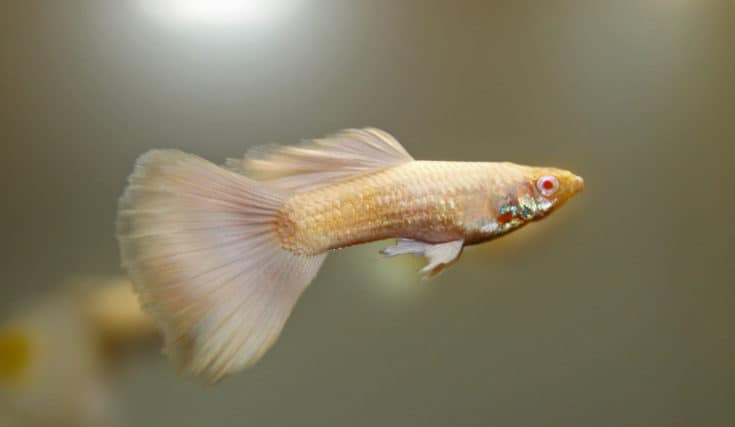
Platinum is another name for guppies with a white or albino body color and pearlescent scales. They would fall under the white or albino class at a guppy show, and there’s no appreciable difference between fish termed platinum vs white.
51. Dragon Head Guppy
Dragon head guppies have a mutation that allows them to exhibit the bright Japanese Blue trait on their heads instead of just their bodies or tail. When combined with other traits, you can get a showstopper of a guppy, like a Dragon Head Snakeskin Delta Tail.
Guppy Type by Eye Color
Guppies naturally have black eyes, unless they are carrying the albino gene, in which case their eyes may appear pink or red-colored.
52. Real Red Eye Guppy
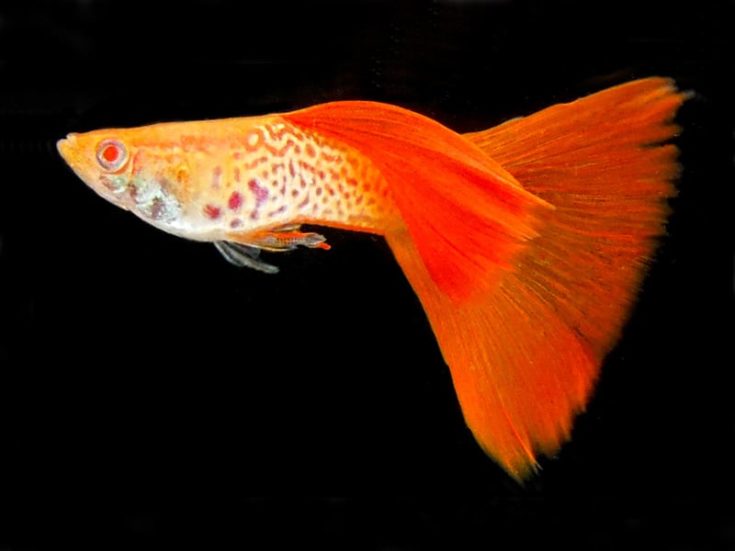
The Real Red Eye guppy (RRE) is a guppy with vivid red eyes that does not carry the albino trait. It’s an uncommon morph, and these fish are usually smaller and have shorter tails, and may be any other mix of colors.
53. Real Red Eye Albino Guppy
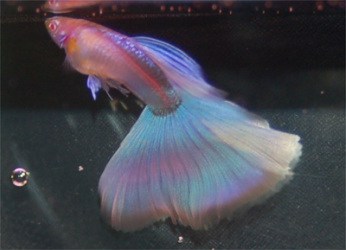
Real Red Eye Albino (RREA) guppies have pink eyes, although their bodies are often a vivid red or show other pale colorations like teal. They often have interesting patterns like Snakeskin or Lace traits.
Other Unique Types of Guppy
There’s a few other types of guppies you may see at shows or for sale from specialty breeders.
54. Dumbo Ear Guppy
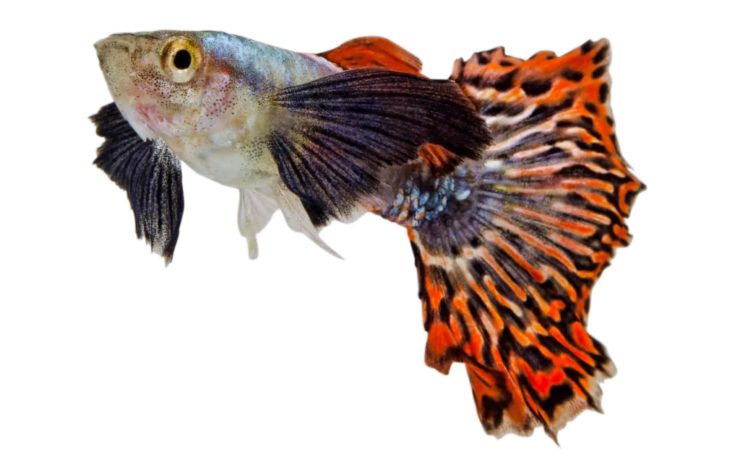
Dumbo ear guppies have extra-long pectoral fins, which make them look as though they are flapping their ears as they swim. This variety is available in a variety of colors and patterns but isn’t especially common to see in stores.
55. Mutt Guppies
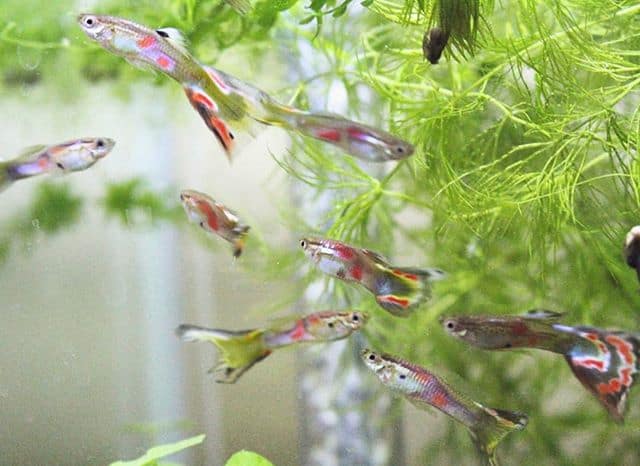
Mutt guppies are fish culled from a breeder’s lines because they lack a desired trait. There’s nothing wrong with these fish, as they are healthy and many are quite stunning, but the breeders simply need to get rid of stock they can’t use for breeding or shows.
Conclusion
You can see why guppies are also known as “Rainbowfish,” since there’s so many colors and patterns to choose from. Once you add in the many tail shapes, it’s no surprise that these friendly and easy to breed fish are so popular in the trade! What’s your favorite guppy color or tail shape? Drop a comment below, or join us on social media.
Curious to know how long guppies live? Check our article here.

Nice information
Guppies are beautiful little fish. Can I ad them to my fancy goldfish aquarium?
Hi, thanks for the question. I don’t usually recommend keeping goldfish and guppies together, unfortunately. First, guppies are a lot smaller than goldfish and they have a hard time competing with them for food. Goldfish, even fancy types, can also be nippy with smaller fish, so I would worry about your guppies getting bullied. Guppies also prefer warmer water than most goldfish, and they have a tendency towards picking up fungal infections, which goldfish can carry and spread.
If you decide to give it a shot (against my recommendation), be sure to provide the guppies with plenty of plants to hide in at the top of the tank. You might also try feeding your fish with the lights off, to reduce competition over food. Just be ready to remove them from your tank if it doesn’t work out.
I actually prefer the mutt guppies 🙂
My father bought a male and two female guppies, all different types. Now we get all sort of beautiful unique colors and patterns! We even got a pair of blue guppies once!
Thanks for detailed information
My father bought a male and two female guppies, all different types. Now we get all sort of beautiful unique colors and patterns! We even got a pair of blue guppies once!